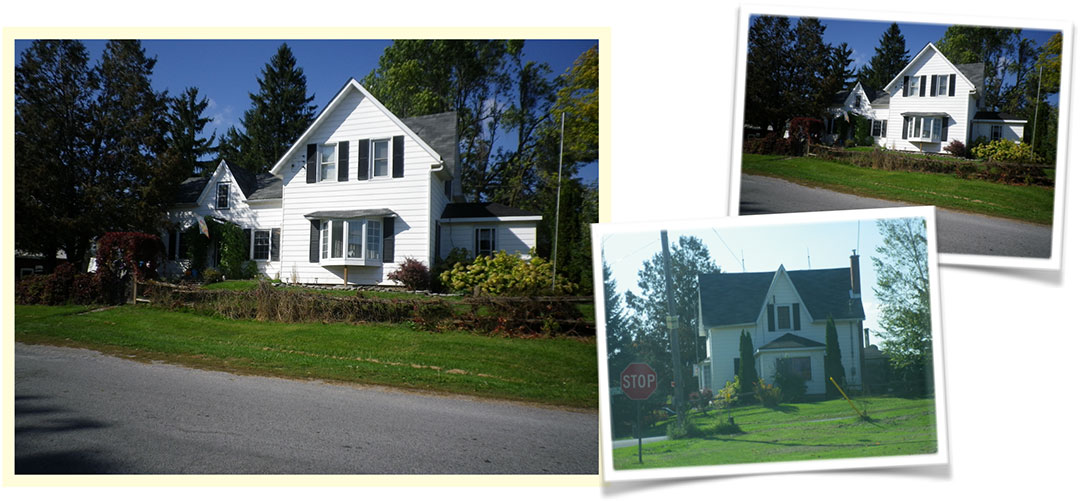1644 Morganston Road, Morganston
(1880)
Roll No. 1411-011-040-07900 – Cramahe Township Ontario

Gothic Revival Farmhouse
The most striking thing about any building described as “Gothic” is the steep gables. This farmhouse has no shortage of Gothic gables.
The steep peaks of the Gothic Farmhouse are well present here and the windows are tall, and slim-ish in appearance with a mixture of what appears to be old and newer windows. There are six over six paned windows on the two visible facades and a number of modern day windows elsewhere. The windows are not Italianate because they do not have the rounded sash.
This house may be clad in aluminium siding because the gauge seems wider than the very old narrow gauge clapboard sometimes found intact (see 3 King Street West, Colborne). It is likely that the narrow gauge clapboard is under the modern siding though it is hard to tell from a street view. Many of the century houses in Northumberland in general and Cramahe in particular were clad in wood clapboard because of the vast variety of timber readily available in the forests of early Upper Canada.
There is a rounded four pane bay window on the south side and an addition under the steep peak facing the highway.
History or Associative Value
Farmer Marcus Wesley Massey bought this property in 1920. Marcus Massey was the grandson of Daniel Massey’s brother (1798-1856). Daniel Massey was the founder of what would become Massey Ferguson Company, and the great grandfather of Vincent Massey (1887-1968) the first Canadian born Governor General of Canada, and Raymond Massey (1896-1983) the famous Hollywood actor. Therefore Marcus was the second cousin of the Massey boys’ father. The house was probably built between 1880 and 1920.
Additional Historical and Genealogical Information
1644 Morgaston Road, Morganston, Ontario Cramahe Township, Concession 9, Lot 17
Lot 17, Concession 9 consists of the 200 acres immediately north and west of Morganston. The first five owners of this land were never residents of Cramahe Township. Alexander Chisholm (?-?), who was granted the property by the Crown on 30 June 1801, lived in Hastings County. John Young (1759-1819) of Quebec City bought the property from him on 28 November 1804. On his death on 14 September 1819, the property was inherited by Young’s son Thomas Ainslie Young (1797-1852), also of Quebec City. The next owner was Charles William Grant (1782-1848, 5th Baron de Longueuil), who acquired the property from Young the younger on 10 February 1823. Grant was a member of the Legislative Council for Lower Canada. On 16 April 1833 he sold the land to William C. Anderson (?-?), an officer in the Royal Artillery and resident of Montreal.
On 2 November 1846 Anderson sold lot to Cramahe farmer Samuel Dingman (1810-1899). Dingman’s wife was Hannah Maria Gould (1812-1895, m. 1836). They had eight children: Joseph George (1838-1917), Sarah Jane (1843-1931), Jacob Wesley (1844-1929), Charles Henry (1847-1935), Willett W. (1851-1925), Norman D. (1855-1938), Norris James (1857-1938), and Henrietta J. (1861-?).
Dingman sold the southeastern-most quarter-acre to his son Willett, also a farmer, on 2 October 1876. Willett was unmarried at the time. He married Catherine Dingwell (1852-1882) in 1878. No reference has been found to children.
Willett Dingman sold his property to his brother Charles Henry Dingman (1847-1935) on 2 March 1880. Like his brother, Charles was unmarried when he acquired the property. He married Agnes Henrietta Wilson (1847-?) in 1884 and had a son Charles Henry (1885-1964). The date of Agnes’s death has not been determined, but Charles married again to Carlisa Gould (1851-?) in 1888. Carlisa was Charles’s first cousin. Interestingly, she apparently was married previously to another of Charles’s first cousins, John Dingman (1812-1887). Charles Dingman’s occupation was variously listed in censuses and land records as farmer, “agent”, and “speculator”. Gazetteers of the day listed him as a dealer in livestock in 1887, 1889, 1893, and 1897.
Charles Henry Dingman owned the property until 15 March 1920, except for a period of a little over 3 years, when it was owned by Charles’ brother Jacob Wesley Dingman (1844-1929). Charles sold it to Jacob on 1 November 1884 and bought it back again on 15 March 1888. Jacob was a farmer who resided in Brighton Township when he bought the property, when he sold it back, and presumably in between.
Charles Henry Dingman sold the property on 15 March 1920 to farmer Marcus Wesley Massey (1849-1938). Massey’s wife was Mary Ann McKague (1852-1945), and they had seven children: William Fletcher (1875-1876), Clarence Wesley (1876-1968), Estella Grace (1880-1899), Frank Percival (1881-1938), William Albert (1885-1966), Mary Winifred (1888-1897), and Lilly Jane (1892-1988). Marcus Massey was the grandson of the brother of Daniel Massey (1798-1856), founder of what would become the Massey Ferguson company, and great grandfather of Vincent Massey (1887-1968), the first Canadian-born Governor General of Canada, and Raymond Massey (1896-1983), famous Hollywood actor. This means that Marcus was the second cousin of the father of the famous Massey boys.
The house at 1644 Morganston Road was definitely built by a Dingman, and probably by Charles Henry Dingman, who owned the property, and probably lived there, for most of 40 years. His brother Willett sold it to him in 1880 for $475. He sold it (plus a bit of adjoining acreage) for $2500. The increase in price probably indicates the house was built between these dates.
Castleton, ON K0K 1M0, Canada
